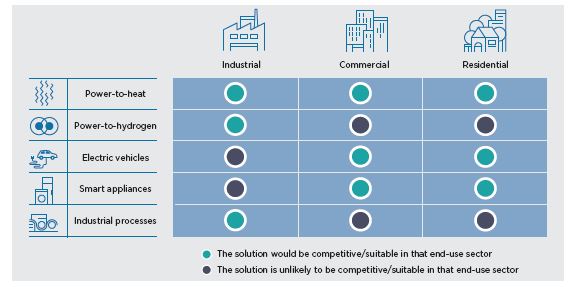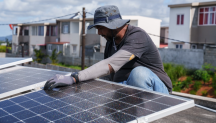

-
-
IRENA (2019), Demand-side flexibility for power sector transformation, International Renewable Energy Agency, Abu Dhabi.
Copied
/-/media/Files/IRENA/Agency/Publication/2019/Dec/IRENA_Demand-side_flexibility_2019.pdf?rev=f2bc0604644e49669e2237b0e98e6eb6
Copied
Demand-side flexibility for power sector transformation
Power systems need to be increasingly flexible to accommodate rising solar and wind shares. This brief examines the uses of demand-side flexibility, outlines solutions to achieve these, and highlights examples in actual power systems.
Newsletter
Power systems need to be increasingly flexible to accommodate rising solar and wind shares. One way to achieve this is by adjusting the demand for electricity to better match generation from solar and wind energy over the course of each hour, day, week or longer timeframe.
This brief from the International Renewable Energy Agency (IRENA) maps out uses, solutions and examples of demand-side flexibility involving different maturity levels and different timescale impacts.
Demand-side flexibility refers to the portion of demand in the system (including via electrified heat and transport) that can be reduced, increased or shifted within a specific duration. Demand-side flexibility must be harnessed to ensure the smooth integration of large shares of variable renewable energy (VRE) into power systems.
Flexibility can be achieved on the demand side by allowing the system operator to control, or provide price signals to, various sources of electricity demand, including power-to-heat, power-to-hydrogen, electric-vehicle charging, smart appliances and industrial demand response.

This brief from the International Renewable Energy Agency (IRENA) maps out uses, solutions and examples of demand-side flexibility involving different maturity levels and different timescale impacts.
Demand-side flexibility refers to the portion of demand in the system (including via electrified heat and transport) that can be reduced, increased or shifted within a specific duration. Demand-side flexibility must be harnessed to ensure the smooth integration of large shares of variable renewable energy (VRE) into power systems.
Flexibility can be achieved on the demand side by allowing the system operator to control, or provide price signals to, various sources of electricity demand, including power-to-heat, power-to-hydrogen, electric-vehicle charging, smart appliances and industrial demand response.
Demand-side flexibility technology mapping by end-use sector





